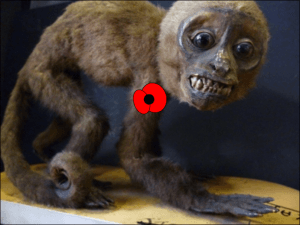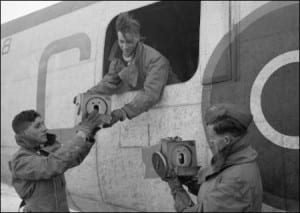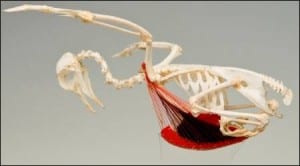Specimen of the Week: Week Fifty-Seven
By Emma-Louise Nicholls, on 12 November 2012
 The guns of the First World War fell silent on the Western Front after over four years of continuous warfare. It was the 11th November 1918 and at 11am on this day the Armistice was signed, officially declaring the Great War to be at an end. The true number of people killed during the First World War will never really be known but current estimates vary greatly from 9 million to 15 million. Either way, it was a tragic loss of life. However, it was not just humans that were involved in the fighting, many species of animal also played their parts. This week for Specimen of the Week, we are commemorating one of the many species of animal that were invaluable to the forces during the Great War and who’s acts saved lives on the Western Front. This week’s Specimen of the Week is…
The guns of the First World War fell silent on the Western Front after over four years of continuous warfare. It was the 11th November 1918 and at 11am on this day the Armistice was signed, officially declaring the Great War to be at an end. The true number of people killed during the First World War will never really be known but current estimates vary greatly from 9 million to 15 million. Either way, it was a tragic loss of life. However, it was not just humans that were involved in the fighting, many species of animal also played their parts. This week for Specimen of the Week, we are commemorating one of the many species of animal that were invaluable to the forces during the Great War and who’s acts saved lives on the Western Front. This week’s Specimen of the Week is…
**The Pigeon**
1) The rock pigeon has been domesticated for thousands of years. Pigeons seen in urban areas sitting on top of statues and in Trafalgar Square before the government banned them, are generally referred to as feral or domesticated pigeons, rather than pure rock pigeons. Selective breeding of rock pigeons has led to the creation of a great many types of pigeon, one of which is the homing pigeon.
2) This special breed of pigeon, plus other animals like horses, dogs, goats, ferrets, mules, cats and rats, were used by humans in the First World War. Homing pigeons were used to deliver messages and were by all accounts a lot more reliable than the rather embyronic radio equipment of the time. It was also harder for the enemy to shoot down a pigeon than to tap into a wireless communication. They became such an asset to the allied forces that in Britain, the punishment for shooting a homing pigeon was six months in jail or a £100 fine. A not unsubstantial amount in 1914.

Crewmen of Consolidated Liberator of No. 53 Squadron RAF handling carriers containing homing pigeons. Image by Miller (F/O), Royal Air Force official photographer. Image taken from http://commons.wikimedia.org/wiki/File:RAF_Liberator_pigeons_WWII_IWM_CH_12364.jpg
3) Pigeons were known for their speed, which made them a hard target for enemy fire, and their sense of direction was second to none. Although a good marksman could down a bird, they were only really susceptible to falcons and hawks and on occasion, a pigeon would be blown off course by gale force winds. However, the only real drawback was their tendency to hole up somewhere cosy and roost for the night, if released after sunset. They would however, duly return to the task of flying home the next morning.
4) In October 1918, Major Charles Whittlesey was trapped under heavy fire with 500 of his men. Within a couple of hours, the number still alive had plummeted to 200. It transpired that they were actually under accidental friendly fire. The major called for Cher Ami, their last homing pigeon, and on a scrap of paper he scribbled the note:
‘We are along road parallel to 276.4. Our own artillery is dropping a barrage directly on us. For heaven’s sake stop it’
Cher Ami flew 25 miles through intense German fire to the artillery site and delivered the message, thus saving the lives of the remaining men. Cher Ami was awarded the French Croix de Guerre, Cross of War for the bravery shown on this and 11 other missions.

A message-carrying pigeon being released from a port-hole in the side of a British tank, near Albert, France. Image by David Mclellan. Image taken from http://commons.wikimedia.org/wiki/File:Messenger_pigion_released_from_British_tank_1918_IWM_Q_9247.jpg
5) Despite the tremendous advances in technology between 1918 and 1945, the RAF still recruited 250,000 pigeons in 1939, for use as messengers during the Second World War. Pigeon lofts became the norm at air bases and bombing raids always carried a few birds with them. In 1939 a Bristol Beufort was shot down over the freezing North Sea. The only surviving homing pigeon had fallen out of the pigeon carrier into an oil slick in the water. The men clambered into the dinghy and watched as she scrambled her way free, shook herself off and launched into the air. The RAF base were already looking for the downed aircraft but had lost radio contact and did not know where to start searching. The following morning an oily, exhausted pigeon flew into the RAF base and although she did not have a message with her, the RAF personnel worked out how long it would have taken her to fly back, taking wind direction into account, and subsequently launched a successful mission to rescue the men. The pigeon was named Winkie because her eyelid drooped with exhaustion, and she became the first recipient of the Dicken Medal. She was the first pigeon to save the lives of RAF crew in World War II.
The skeletal pigeon specimen at the Grant Museum of Zoology shows the powerful flight muscles that enabled the homing pigeons of the First and Second World Wars to deliver their messages ‘nine times out of ten’.
Thank you to the Imperial War Museums Archives and the excellent publication ‘The Animals’ War: Animals in wartime from the First World War to the present day’ by Juliet Gardiner, published by the Imperial War Museum, for the information included in this blog.
Emma-Louise Nicholls is the Museum Assistant at the Grant Museum of Zoology
 Close
Close


